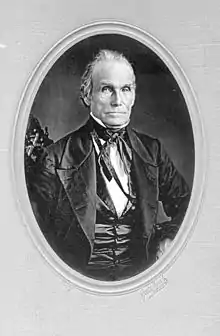James Harper (congressman)
James Harper (March 28, 1780 – March 31, 1873) was a Philadelphia businessman, manufacturer, civic leader and two-term member of the U.S. House of Representatives from Pennsylvania.
James Harper | |
|---|---|
 James Harper in around 1870, portrait photograph by Frederick Gutekunst. | |
| Member of the U.S. House of Representatives from Pennsylvania's 2nd district | |
| In office March 4, 1833 – March 3, 1837 | |
| Preceded by | Henry Horn |
| Succeeded by | See below |
| Personal details | |
| Born | March 28, 1780 Castlederg, County Tyrone, Kingdom of Ireland |
| Died | March 31, 1873 (aged 93) Philadelphia, Pennsylvania, U.S. |
| Political party | Anti-Jacksonian |
Biography
James Harper was born in Castlederg, County Tyrone in the Kingdom of Ireland to a family of minor gentry who had moved there from England during the Plantation of Ulster.[1] As a youth, Harper immigrated to the United States with his parents, and settled in Philadelphia. He rose to prominence in commerce, engaging in the manufacture of brick and from 1820 to 1830 in the wholesale grocery trade. He married Charlotte Sloan Alford, a member of an established Pennsylvania Quaker family. Like many powerful men of the early Republic, he was a Freemason, and was elected to the position of Grand Master of Pennsylvania in 1824.[2] As Grand Master, he hosted fellow mason the Marquis de Lafayette during the latter's "Farewell Tour" of the United States in 1825.
In 1832 Harper was elected to the United States Congress as a National Republican (Anti-Jacksonian), and represented Pennsylvania's Second Congressional District in the Twenty-third and Twenty-fourth Congresses. His letters from Washington, some of which are preserved in the Historical Society of Pennsylvania, reflect a disgust with the endemic corruption of Andrew Jackson and his administration. He chose not to stand for reelection in 1836. In Congress he allied himself with Henry Clay, and followed Clay in commissioning his portrait from the Philadelphia painter John Neagle.

Upon his retirement from Congress, Harper continued in the manufacture of brick, also branching out into real estate speculation and urban development. Having bought the north side of Philadelphia's then undeveloped Rittenhouse Square, he built a fine house for himself at 1811 Walnut Street in around 1840. Setting a patrician residential tone for the square with this edifice, he sold off the remaining lots at profit. The front part of his house, sold after his death to the Social Arts Club (an exclusive men's club that thereupon renamed itself the Rittenhouse Club), still stands behind the 1901 facade that the club added.[3][4]
In Philadelphia Harper was a member of the Board of Guardians of the Poor and of the Board of Prison Inspectors. A patron of science, Harper was one of the founders of the Franklin Institute in 1824,[5] and a delegate to the Great Exhibition of the Works of Industry of all Nations (often called the "Crystal Palace Exhibition") in London in 1851. Harper was a pewholder at St. Stephen's Episcopal Church, and died in Philadelphia in 1873. Of his ten children, eight survived to adulthood and several of those entered public life: Alexander J. Harper was President of the Philadelphia City Council, Benjamin West Harper (named after Charlotte Harper's relative Benjamin West) was a businessman and lieutenant colonel in the Pennsylvania National Guard, and Thomas Scott Harper was a physician and president of the Medical Board of Philadelphia.[6] Harper is buried, along with other members of his family, in Laurel Hill Cemetery.[7]
References
- Though they have sometimes been identified in the literature as Scots-Irish, the English origin of the Harpers is documented in archival material and corroborated by a published account of the Castlederg Harpers in "The Biographical Cyclopædia and Portrait Gallery with an Historical Sketch ...," (Cincinnati: Western Biographical Publishing Co., 1887) Vol. 4, p. 927.
- Augustus Row, Masonic Biography and Dictionary…, Philadelphia: 1868, p. 126
- Burke, Bobbye and Trina Vaux (1985). Historic Rittenhouse, a Philadelphia Neighborhood. Philadelphia: U of Pennsylvania, 1985. Philadelphia: University of Pennsylvania Press.
- Heinzen, Nancy (2009). The Perfect Square: A History of Rittenhouse Square. Philadelphia: Temple University Press. pp. 29–31.
- Charter of Incorporation, Constitution and By-Laws of the Franklin Institute of the State of Pennsylvania for the Promotion of the Mechanical Arts, Philadelphia: William Fry, 1824, p. 17
- John Hugh Campbell, History of the Friendly Sons of St. Patrick and of the Hibernian Society…, Philadelphia: 1892, pp. 423-424
- "James Harper". www.findagrave.com. Retrieved July 10, 2020.
Sources
- Burke, Bobbye and Trina Vaux (1985). Historic Rittenhouse, a Philadelphia Neighborhood. Philadelphia: U of Pennsylvania, 1985. Philadelphia: University of Pennsylvania Press.
- Heinzen, Nancy (2009). The Perfect Square: A History of Rittenhouse Square. Philadelphia: Temple University Press.
- United States Congress. "James Harper (id: H000221)". Biographical Directory of the United States Congress.
- The Political Graveyard
| U.S. House of Representatives | ||
|---|---|---|
| Preceded by Henry Horn |
Member of the U.S. House of Representatives from Pennsylvania's 2nd congressional district 1833–1837 1833-1835 alongside: Horace Binney 1835-1837 alongside Joseph R. Ingersoll |
Succeeded by John Sergeant and George Washington Toland |